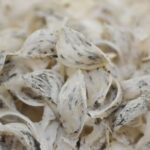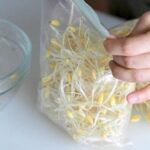How to Select Fresh Squid
Fresh squid usually has clear, translucent skin that still has a slight shimmer. When transported over long distances, properly frozen squid will have a slight pink hue, with clear, black eyes, and intact, firmly attached tentacles. Pressing on the squid’s body should feel firm and spring back.
Avoid buying squid with easily detachable heads and bodies, cloudy eyes, or flesh that feels soft and lacks resilience when pressed. Fresh squid should also not have any unusual odors.

First, choose fresh, good-quality squid and clean it thoroughly. This will ensure that your steamed squid doesn’t have a fishy smell.
Preparing the Squid
Rinse the squid to remove any slime and eliminate any fishy odor. It is also important to remove the ink sac to maintain the white color of the squid during steaming and when served.
For squid with eggs, hold the upper half of the squid firmly and use a spoon or scissors to gently scoop out the eggs, being careful not to detach the head. This will ensure that the squid remains intact.
To further reduce any fishy odor, soak the squid in a solution of diluted salt water with a splash of vinegar or lemon juice, then rinse and pat dry.
Steaming the Squid
– Spices for Steaming Squid
To enhance the flavor of steamed squid, marinate it with pepper, seasoning powder, salt, fish sauce, or a small amount of white wine to neutralize any fishy taste. As the squid will be served with various sauces, go easy on the salt, fish sauce, and seasoning powder. Squid, being a seafood, has a natural salinity, and some prefer to steam it without any marinade to preserve its authentic flavor.
For steamed squid, you will need a variety of herbs to neutralize any fishy odor. Commonly used ingredients include ginger, lemongrass, scallions, and onions. Slice the ginger, cut the onions into wedges, and chop the scallions into sections. You can also add chili for an extra kick and to further eliminate any fishiness. Adjust the spices according to your family’s taste preferences.
Additionally, depending on the region, the method of steaming and the spices used can vary.

When steaming squid, prepare some spices to eliminate any fishy odor and make the dish more appealing.
– Steaming Squid with Piper Sarmentosum Leaves
This is an effective method to eliminate the fishy odor of squid and enhance its flavor. Choose piper sarmentosum leaves that are neither too young nor too old. Rinse the leaves and let them air dry. Chop some of the leaves into strips, and set the rest aside to wrap the squid when serving.
– Steaming Time for Squid
Arrange the squid on a plate or tray, interspersing it with spices like ginger, lemongrass, piper sarmentosum leaves, and onion.
Bring a small amount of water to a boil and place the squid in a steamer. Steam the squid for approximately 8-10 minutes, depending on the size and quantity of the squid.
Once the squid is cooked, sprinkle chopped scallions on top and let it rest briefly before serving. Steamed squid is best served hot to ensure optimal flavor and to prevent any fishy smell.
– Steaming Squid with Beer
Instead of using plain water, try steaming the squid with beer. This will add a unique flavor to the dish and help eliminate any fishy odor.
How to Keep Bean Sprouts Fresh, Crisp, and Free From Discoloration for Extended Storage
Bean sprouts are an essential ingredient in any kitchen and refrigerator. Their versatility shines in various dishes, from salads to stir-fries. However, a common issue arises when you don’t cook them immediately after purchase; they tend to turn black, wilt, and rot, losing their freshness and appeal.



































